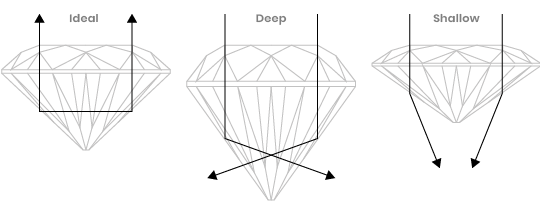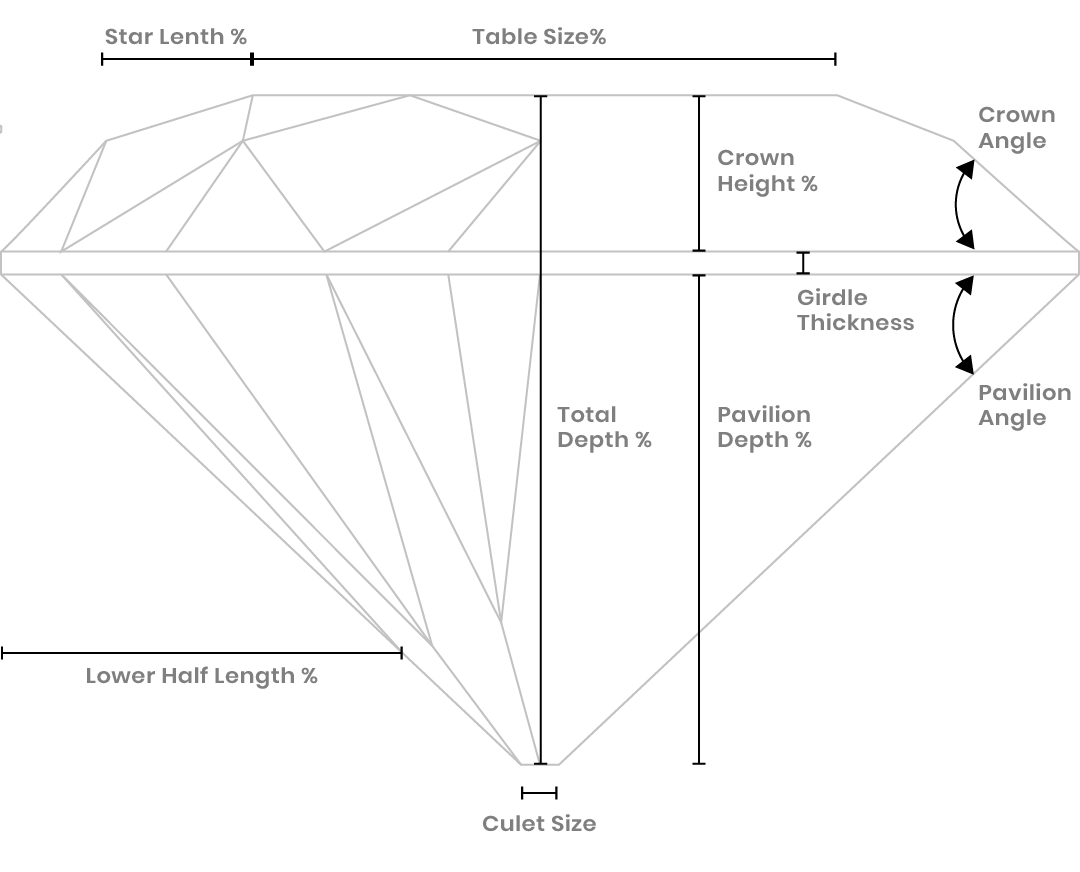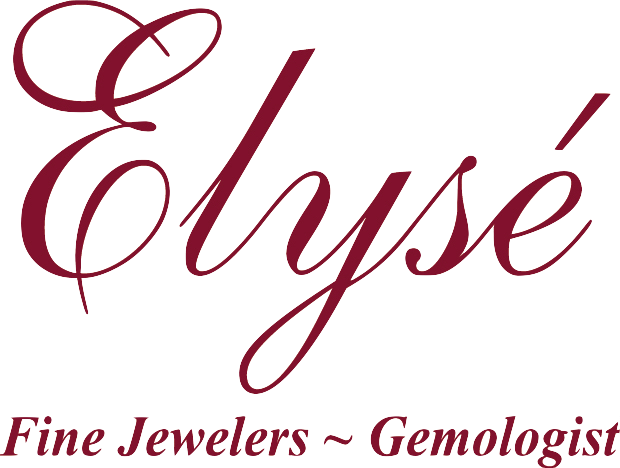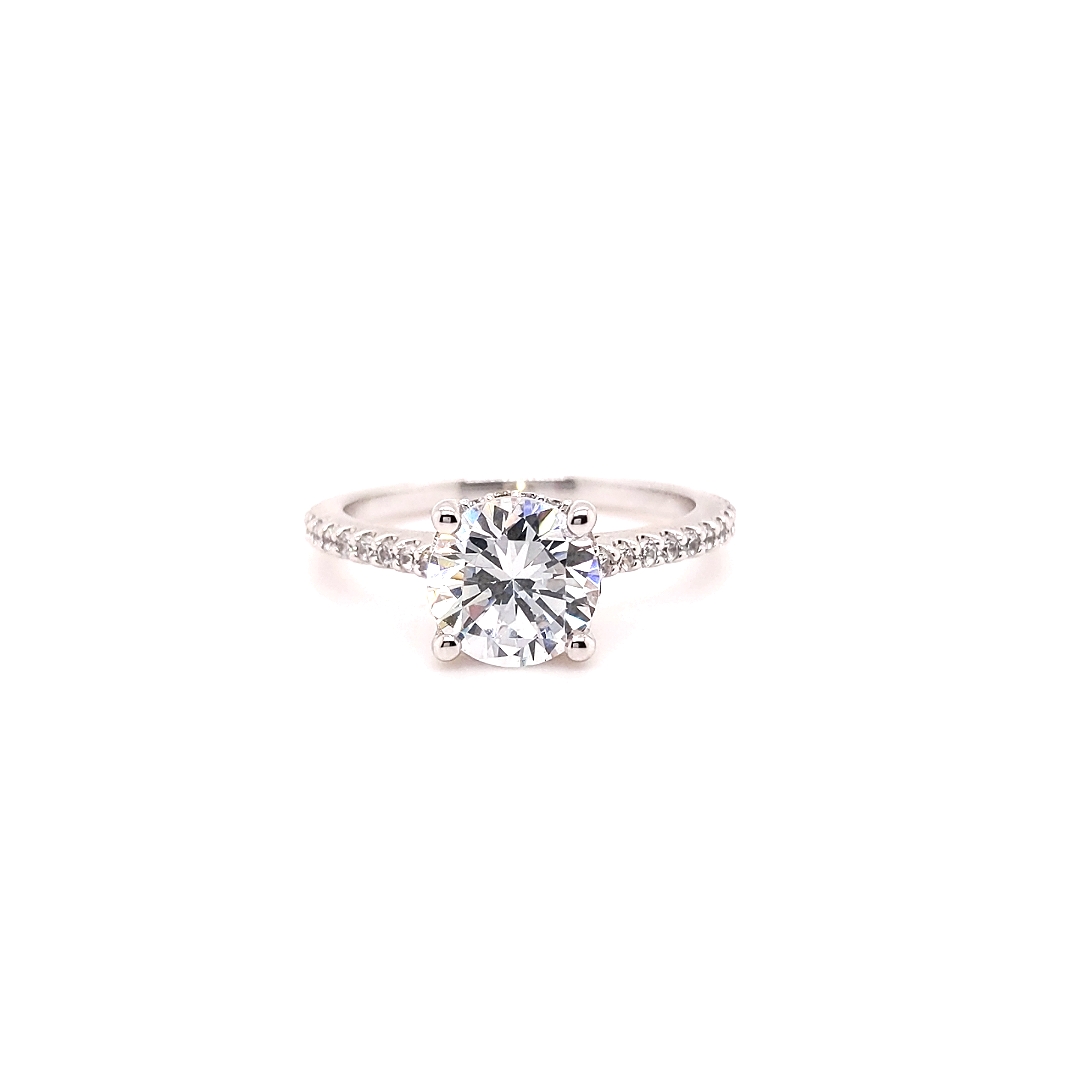Diamond Education
The 4 C'sDiamond Anatomy & Quality
The process of selecting a Diamond begins with understanding its Anatomy and what you need to know to determine a diamond’s Quality and inherent Value.
It’s important to know that we hand select every Diamond offered for sale at Elyse. Nature doesn’t give us two things that are the same and you are not buying a piece of paper (Certificate), but a unique gift from nature. An Elyse Diamond is not offered based on the grading specification alone, but after careful inspection of its characteristics to assure visual beauty and brilliance.
When working with us to acquire a Diamond, we always begin with a 30 minute “Diamonds-101” Class. The outline of the topics included in the class follows. These are a guideline to help you understand the subtle differences in a diamond that have a huge affect on the way it looks and its price.
Understanding the 4 C’s of Diamond Shopping
All jewelers and websites refer to the 4-C’s of Diamond grading. Most focus on Color and Clarity, but all of the 4-C’s work together to determine the overall quality, cost and inherent value of your investment. The goal is to find the right balance between each of the 4-C’s to select the best stone for your Ring, at the price you are comfortable spending. We hand select and show you a collection of Diamonds for your consideration that fall within the parameters that work for you! It’s a big part of what makes Elyse Jewelers different from others.
Diamond Shapes
There are a variety of shapes and dimensions that Diamonds are available in. Selecting the right shape of a diamond to not only suite your personal taste, but your physical features as well, is part of what makes a finished Ring look amazing. For example, do you have long, slim fingers? Then consider a diamond shape that compliments these features. Having the right shape diamond on your finger is an important factor in selecting a stone.
Remember, Shape is not Cut. It’s easy to confuse since the word “Cut” is used to identify most Diamond Shapes, ie: Round Brilliant-Cut, Cushion-Cut, Emerald-Cut, Princess-Cut, etc. These are Diamond Shapes. A Diamond’s Cut, or its perfect geometric specifications based on its Shape is completely different.


Diamond Shape Descriptions
Emerald Cut: Emerald cut diamonds are usually rectangular in shape. Distinguished by beveled corners and step facets, this type of diamond is more transparent than other shapes, often requiring higher standards of clarity.
Marquise Cut: The marquise cut is rumored to have been specially developed for King Louis XIV of France who wanted a diamond that simulated the smile of Marquise de Pompadour. The elongated Marquise stone has gracefully pointed ends for a dramatically beautiful appeal.
Pear Brilliant Cut: Exuding elegance, the Pear shape diamond (also referred to as a drop cut or teardrop diamond) is cut to resemble a drop of water with a single point and rounded end. The result is a cross between a round and marquise cut.
Oval Brilliant Cut: Cut with the same number of facets as a round diamond, an Oval shape emits nearly the same level of brilliance and fire. Due to its elongated shape, the Oval Brilliant cut can appear larger than a round diamond of equal carat (weight).
Round Brilliant Cut: The most commonly chosen shape, Round Brilliant cut diamonds have been researched by gemologists more than any other variation. Renowned for its unrivaled fire and brilliance, this shape boasts excellent light refraction properties.
Princess Cut: A square stone with 90-degree corners, the Princess cut originated in the United States in 1980. The most desirable Princess cut diamonds are perfectly square in shape.
Cushion Cut: First introduced to the jewelry market in the early 1800’s, the Cushion cut diamond is rich with diamond history. Cut into a square or rectangular shape with rounded corners and sides, it’s considered by many to be a more vintage version of the Round Brilliant cut diamond.
Asscher Cut: Introduced in 1902 by renowned diamond cutter Joseph Asscher, this diamond shape utilizes many of the same cutting techniques as the Emerald cut. What sets Asscher Cut diamonds apart are their uniquely angled and cropped corners, creating a timeless look.
Heart Shape: Living up to its name, the Heart Shape diamond has become synonymous with love and affection, making it an excellent choice for an anniversary or engagement ring or pendant. One of the most demanding diamond cuts to create, a heart shaped stone requires great skill and dexterity from the diamond cutter.
Radiant Cut: Relatively new to the jewelry industry, Radiant cut diamonds were introduced in 1977. This unique shape is a stunning hybrid of a traditional Round Brilliant cut and an elegant Emerald cut, resulting in a square, near-square, or rectangular orientation. As the name suggests, Radiant cut diamonds tend to emit a beautiful, memorable glow.
C#1 – Carat Weight (Size)
This is the easiest of the 4-C’s to understand. Simply, it refers to how large the diamond is. Diamonds are weighed in a unit of measure called Carats. One Carat of Diamond weight is made up of 100 points. We like to compare it to having $1 Dollar, which is made up of 100 Pennies. A Diamond’s size/weight is the first of the C’s that determine cost. Generally speaking, Diamonds of the same Shape, Color, Clarity and Cut grade will have a similar Price per Carat based on size/weight.


Diamond Sizing Descriptions
Diamond carat weight is the measurement of how much a diamond weighs. A metric “carat” is defined as 200 milligrams. Each carat can be subdivided into 100 ‘points.’ This allows very precise measurements to the hundredth decimal place. A jeweler may describe the weight of a diamond less than one carat by its ‘points’ alone. For instance, the jeweler may refer to a diamond that weighs 0.25 carats as a ‘twenty-five pointer.’ Diamond weights greater than one carat are expressed in carats and decimals. A 1.08 carat stone would be described as ‘one point oh eight carats.’
HOW DID THE CARAT SYSTEM START?
The modern carat system started with the carob seed. Early gem traders used the small, uniform seeds as counterweights in their balance scales. The carat is the same gram weight in every corner of the world.
WHAT ARE “MAGIC SIZES”?
Some weights are considered “magic sizes” – half carat, three-quarter carat, and carat. Visually, there’s little difference between a 0.99 carat diamond and one that weighs a full carat. But the price differences between the two can be significant.
C#2 – Color
What we seek in a Diamond is absence of Color, wanting the stone to be as white as it can be, unless you are seeking a Natural Colored Diamond. For our purposes here, we are assuming a traditional White Diamond.
The grading of a Diamond’s Color is made up of three components:
- Hue: the basic sensation of Color
- Tone: the relative lightness or darkness of Color
- Saturation: the strength of Color
Diamond Color is graded on an alphabet scale ranging from D to Z. The whitest of the Diamonds are the ranges of D-E-F (known as Colorless) followed by G-H-I-J (Near Colorless) and so forth. Each letter represents a minute range of Color.
As you come down the alphabet scale, the stones take on an increasingly noticeable tint – most often yellow – resulting in lowering the Price per Carat cost. Many factors influence how the color is perceived, including Shape of the Diamond and Cut Grade.
Natural Fancy Color Diamonds are graded on a different scale and have distinct, attractive natural tints of deeper Yellows and Browns most commonly, along with rarer colors of Orange, Pink, Green and Blue. These are graded as Fancy Light, Fancy, Fancy Intense and Fancy Vivid, followed by a description of the Color, ie: Fancy Intense Yellow, Fancy Pink, Fancy Light Blue, Fancy Vivid Brownish-Yellow, etc.


Diamond Color Descriptions
D, E, F – Colorless
G, H, I, J – Near Colorless
K, L, M – Faint Yellow
N – R – Very Light Yellow
S – Z – Light Yellow
Beyond the Alphabet designations, for each of the Fancy colors (Yellow, Pink, Brown, Blue, etc)
Fancy Light – Color is no longer a modifier to white, but the dominant hue
Fancy – Color is more evenly distributed and predominant
Fancy Intense – Color is intense, well distributed and rich
Fancy Vivid – Color is deep, fully saturated and vivid
C#3 – Clarity
Diamond Clarity is often misrepresented as flaws in the Diamond. Clarity characteristics are the natural birthmark, or finger print of the stone, and no two diamonds are alike. Clarity characteristics fall into two categories; Blemishes, which are external and Inclusions, which are internal. Some are easier to see than others.
All Diamonds are graded under 10x magnification. Selecting a Diamond to minimize clarity characteristics, along with where they fall on the stone’s structure is part of the art of hand-selecting a Diamond. We only present Diamonds for your consideration that are “eye clean”, meaning there are no visible clarity characteristics without the aid of magnification and some guidance from us to see them under a microscope.


Diamond Clarity Descriptions
IF Internally Flawless – No inclusions and only blemishes are visible to a skilled grader using 10x magnification.
VVS1 –VVS2 Very Very Slightly Included – Minute inclusions that range from extremely difficult to very difficult to see by a skilled grader using 10x magnification.
Vs1 – Vs2 Very Slightly Included – Minor inclusions that range from difficult to somewhat easy to see by a skilled grader using 10x magnification.
SI1 – SI2 Slightly Included – Noticeable inclusions that range from easy to very easy to see by a skilled grader using 10x magnification.
I1 Included – Obvious inclusions are visible to a skilled grader using 10x magnification and may affect transparency and brilliance.
I2 Included – Obvious inclusions are visible to a skilled grader using 10x magnification or the naked eye and may affect transparency and brilliance.
I3 Included – Extremely Obvious inclusions are easily visible to the naked eye, and will affect transparency and brilliance and potentially the durability of the stone.
C#4 – Cut
Cut grade in the Diamond world refers to a specific set of geometric specifications, angles and faceting based on a Diamond’s Shape to create maximum brilliance, fire and scintillation. A properly cut and proportioned Diamond captures light entering the stone, then reflects off of the facets back to the eye through the top Table. A diamond that is cut too shallow causes light to escape from the bottom of the stone. One that is cut too deep causes light to escape out of the sides.
A Diamond that is not cut to optimal proportions is known as “Off Make” and can sell for 30% to 45% less than a perfectly Cut and Proportioned stone. Diamond sparkle and brilliance is all about the Cut Grade and has nothing to do with Color or Clarity. Cut Grade is not the place to hold back when maneuvering through the 4-C’s to select the right Diamond.


Book an Appointment
Book a personalized appointment to meet with Richard and our team.

